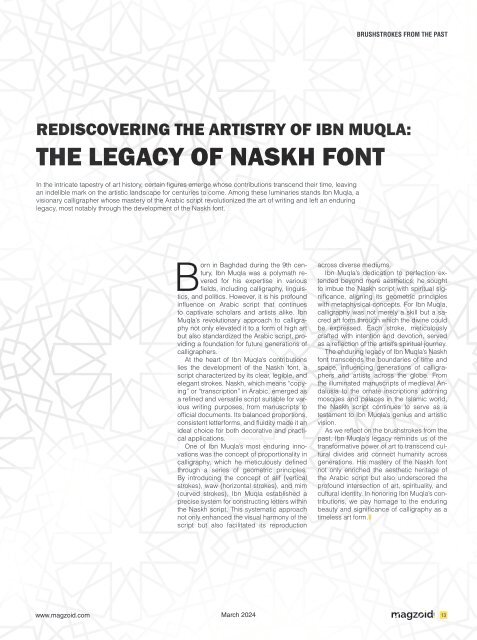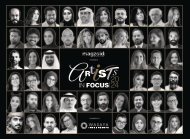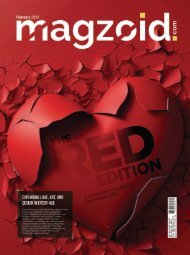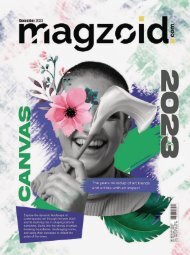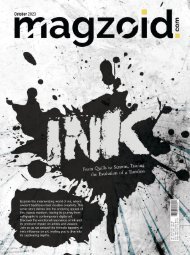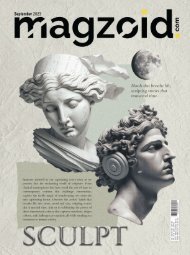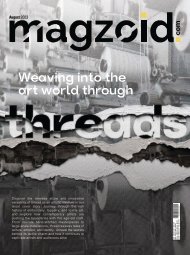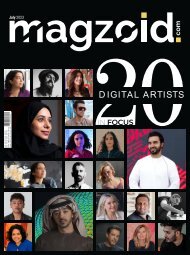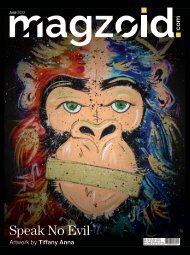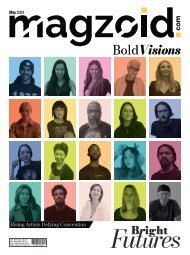Magzoid Magazine - Luxury Magazine in the Creative Space | March 2024 |
“Calligraphy is the most intimate, private, and spontaneous expressive means. Like a fingerprint or voice, it is unique with every person.” ― Hermann Zapf Welcome to the March edition of Magzoid Magazine, where creativity takes center stage in our special collaboration with Brands for Less and artist Advay Sureka. Our cover story celebrates the limitless possibilities of creativity with a unique partnership, promising an exploration of innovation and imagination. In our exclusive interview, artist Filippo Minelli unveils the intricate relationship between urbanism, cultural identity, and globalization through his exhibition, "The Idealised City." As the month begins, we also mark the beginning of Ramadan, a time of spiritual reflection and community.
“Calligraphy is the most intimate, private, and spontaneous expressive means. Like a fingerprint or voice, it is unique with every person.”
― Hermann Zapf
Welcome to the March edition of Magzoid Magazine, where creativity takes center stage in our special collaboration with Brands for Less and artist Advay Sureka.
Our cover story celebrates the limitless possibilities of creativity with a unique partnership, promising an exploration of innovation and imagination.
In our exclusive interview, artist Filippo Minelli unveils the intricate relationship between urbanism, cultural identity, and globalization through his exhibition, "The Idealised City."
As the month begins, we also mark the beginning of Ramadan, a time of spiritual reflection and community.
You also want an ePaper? Increase the reach of your titles
YUMPU automatically turns print PDFs into web optimized ePapers that Google loves.
BRUSHSTROKES FROM THE PAST<br />
REDISCOVERING THE ARTISTRY OF IBN MUQLA:<br />
THE LEGACY OF NASKH FONT<br />
In <strong>the</strong> <strong>in</strong>tricate tapestry of art history, certa<strong>in</strong> figures emerge whose contributions transcend <strong>the</strong>ir time, leav<strong>in</strong>g<br />
an <strong>in</strong>delible mark on <strong>the</strong> artistic landscape for centuries to come. Among <strong>the</strong>se lum<strong>in</strong>aries stands Ibn Muqla, a<br />
visionary calligrapher whose mastery of <strong>the</strong> Arabic script revolutionized <strong>the</strong> art of writ<strong>in</strong>g and left an endur<strong>in</strong>g<br />
legacy, most notably through <strong>the</strong> development of <strong>the</strong> Naskh font.<br />
Born <strong>in</strong> Baghdad dur<strong>in</strong>g <strong>the</strong> 9th century,<br />
Ibn Muqla was a polymath revered<br />
for his expertise <strong>in</strong> various<br />
fields, <strong>in</strong>clud<strong>in</strong>g calligraphy, l<strong>in</strong>guistics,<br />
and politics. However, it is his profound<br />
<strong>in</strong>fluence on Arabic script that cont<strong>in</strong>ues<br />
to captivate scholars and artists alike. Ibn<br />
Muqla’s revolutionary approach to calligraphy<br />
not only elevated it to a form of high art<br />
but also standardized <strong>the</strong> Arabic script, provid<strong>in</strong>g<br />
a foundation for future generations of<br />
calligraphers.<br />
At <strong>the</strong> heart of Ibn Muqla’s contributions<br />
lies <strong>the</strong> development of <strong>the</strong> Naskh font, a<br />
script characterized by its clear, legible, and<br />
elegant strokes. Naskh, which means “copy<strong>in</strong>g”<br />
or “transcription” <strong>in</strong> Arabic, emerged as<br />
a ref<strong>in</strong>ed and versatile script suitable for various<br />
writ<strong>in</strong>g purposes, from manuscripts to<br />
official documents. Its balanced proportions,<br />
consistent letterforms, and fluidity made it an<br />
ideal choice for both decorative and practical<br />
applications.<br />
One of Ibn Muqla’s most endur<strong>in</strong>g <strong>in</strong>novations<br />
was <strong>the</strong> concept of proportionality <strong>in</strong><br />
calligraphy, which he meticulously def<strong>in</strong>ed<br />
through a series of geometric pr<strong>in</strong>ciples.<br />
By <strong>in</strong>troduc<strong>in</strong>g <strong>the</strong> concept of alif (vertical<br />
strokes), waw (horizontal strokes), and mim<br />
(curved strokes), Ibn Muqla established a<br />
precise system for construct<strong>in</strong>g letters with<strong>in</strong><br />
<strong>the</strong> Naskh script. This systematic approach<br />
not only enhanced <strong>the</strong> visual harmony of <strong>the</strong><br />
script but also facilitated its reproduction<br />
across diverse mediums.<br />
Ibn Muqla’s dedication to perfection extended<br />
beyond mere aes<strong>the</strong>tics; he sought<br />
to imbue <strong>the</strong> Naskh script with spiritual significance,<br />
align<strong>in</strong>g its geometric pr<strong>in</strong>ciples<br />
with metaphysical concepts. For Ibn Muqla,<br />
calligraphy was not merely a skill but a sacred<br />
art form through which <strong>the</strong> div<strong>in</strong>e could<br />
be expressed. Each stroke, meticulously<br />
crafted with <strong>in</strong>tention and devotion, served<br />
as a reflection of <strong>the</strong> artist’s spiritual journey.<br />
The endur<strong>in</strong>g legacy of Ibn Muqla’s Naskh<br />
font transcends <strong>the</strong> boundaries of time and<br />
space, <strong>in</strong>fluenc<strong>in</strong>g generations of calligraphers<br />
and artists across <strong>the</strong> globe. From<br />
<strong>the</strong> illum<strong>in</strong>ated manuscripts of medieval Andalusia<br />
to <strong>the</strong> ornate <strong>in</strong>scriptions adorn<strong>in</strong>g<br />
mosques and palaces <strong>in</strong> <strong>the</strong> Islamic world,<br />
<strong>the</strong> Naskh script cont<strong>in</strong>ues to serve as a<br />
testament to Ibn Muqla’s genius and artistic<br />
vision.<br />
As we reflect on <strong>the</strong> brushstrokes from <strong>the</strong><br />
past, Ibn Muqla’s legacy rem<strong>in</strong>ds us of <strong>the</strong><br />
transformative power of art to transcend cultural<br />
divides and connect humanity across<br />
generations. His mastery of <strong>the</strong> Naskh font<br />
not only enriched <strong>the</strong> aes<strong>the</strong>tic heritage of<br />
<strong>the</strong> Arabic script but also underscored <strong>the</strong><br />
profound <strong>in</strong>tersection of art, spirituality, and<br />
cultural identity. In honor<strong>in</strong>g Ibn Muqla’s contributions,<br />
we pay homage to <strong>the</strong> endur<strong>in</strong>g<br />
beauty and significance of calligraphy as a<br />
timeless art form.<br />
www.magzoid.com <strong>March</strong> <strong>2024</strong><br />
13


